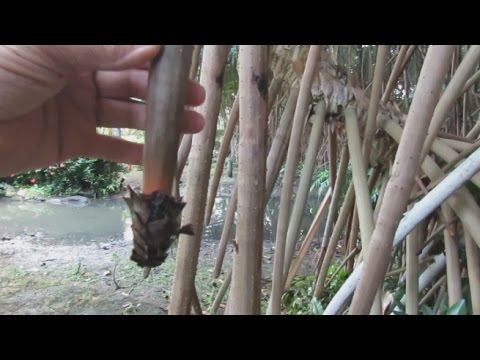Manglares Dominicanos: Extraordinaria Naturaleza. Mangroves Dominicans: Extraordinary Nature.
El mangle es un arbusto o árbol de las rizofóreas que tiene frutos , de tres a cuatro metros de altura, aunque a veces alcanza unos 15 m o más. Sus ramas largas y extendidas dan unos vástagos que descienden hasta tocar el suelo y arraigar en él. Tiene hojas pecioladas, opuestas, enteras, elípticas, obtusas y gruesas; flores axilares de cuatro pétalos amarillentos; fruto seco de corteza coriácea, pequeño y casi redondo y muchas raíces externas .
Es muy abundante en las costas, cayos y ciénagas de América Intertropical. Las ramas colgantes de los mangles se hunden en tierra, echan raíces y se entrelazan formando impenetrables barreras en las que se refugian peces y se adhieren y viven moluscos. Es la planta más representativa de la vegetación halófita ya que tolera una elevada salinidad como la que hay en las aguas costeras de la zona intertropical y, más aún, en las lagunas o albuferas en contacto con el mar, donde la concentración de sal es generalmente mayor. En las regiones costeras constituye una planta pionera, ya que se establece primero y constituye la base para que muchas otras especies de plantas y, sobre todo, de animales, se establezcan después.
El hábitat del mangle es exclusivamente tropical e intermareal, teniendo por lo tanto el suelo o sedimento saturado de agua y salino o de salinidad variable. En ellos se encuentra una amplia variedad de especies vegetales, pero los “verdaderos manglares” —especies que típicamente se encuentran en manglares y sólo excepcionalmente en otros sitios los constituyen unas 54 especies pertenecientes a 20 géneros, encuadrados en 16 familias.
Fuente: Wikipedia :
Canal El Angelito:
The mangrove is a shrub or tree of rizofóreas having fruit, three to four meters in height, although sometimes reaches 15 m or more. His long, spreading branches give shanks that descend to the ground and take root in him. Has stalked, opposite, entire, elliptical, obtuse, thick leaves; axillary yellow flowers four petals; nut leathery, small and almost round crust and many external roots.
It is very abundant on the coasts, keys and swamps Intertropical America. Overhanging branches of the mangroves sink on land, take root and intertwine to form impenetrable barriers where fish shelter and stick and live molluscs. It is the most representative plant halophyte vegetation and tolerates high salinity as the one in the coastal waters of the tropics and, even more, in lagoons or ponds in contact with the sea, where the salt concentration is generally higher. In coastal regions is a pioneer plant, because it is established first and forms the basis for many other species of plants and especially animals, be established later.
Mangrove habitat is exclusively tropical and intertidal, thereby having the ground or water and saturated saline or variable salinity sediment. They contain a wide variety of plant species, but the “true mangroves” -Securities typically found in mangroves and only exceptionally elsewhere those are about 54 species belonging to 20 genera, set in 16 families.
Source: Wikipedia:
Canal El Angelito:

